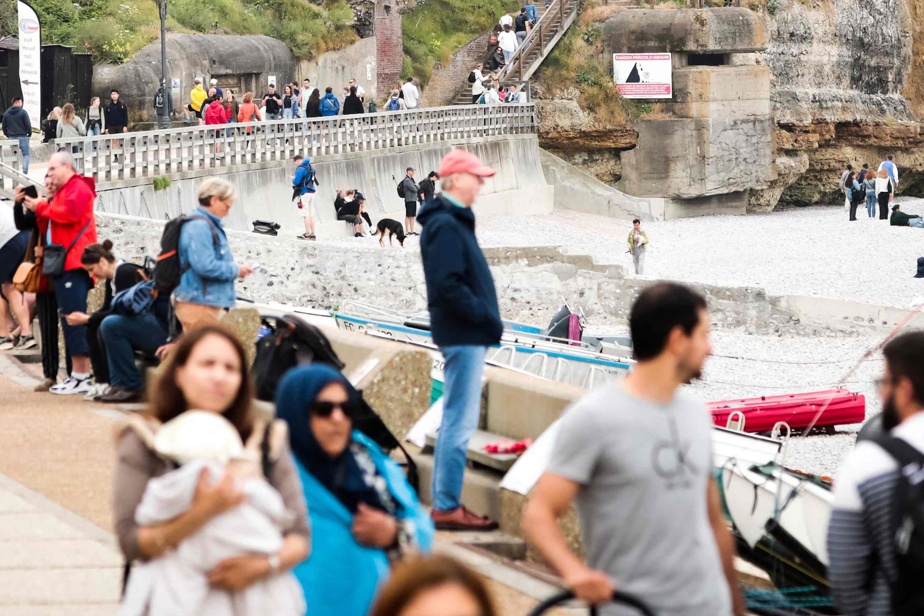(Étretat) “We would like it to no longer be Disneyland”: the inhabitants of Étretat, a Norman town which sees its population multiply by ten in summer, denounce the effects of “drunk” overtourism, which despite certain economic fallout dispossesses the premises of their city and damages the natural heritage.
Sitting on his boat stranded on the beach, with a breathtaking view of the famous needle for which his town is famous, Quentin Maze believes that there is “a real concern with mass tourism”, the situation becoming “of Getting worst “. “People arrive with their picnic, degrade the place, leave their waste,” says the 35-year-old sailor, born in Étretat.
His main fight? The disappearance of the pebbles – nearly 400 kg each summer – taken away as a souvenir: a gesture that has direct consequences on the local ecosystem, but also on its activity.
“When I was little, the pebbles came all the way up there,” he explains, pointing to the top of the beach. With their disappearance, “putting boats in the water becomes complicated”, especially since tourists do not respect the channel area. Even if he “makes war individually” on these behaviors, it is not enough.
Beyond his situation, the sailor explains that overtourism “takes up a lot of space” and makes it “impossible to live here in summer”. “It is becoming complicated to park and find accommodation” with the proliferation of tourist accommodation, he explains with his Norman accent, so that people are leaving and “schools are closing”.
“Phantom Periods”

PHOTO CHARLY TRIBALLEAU, AGENCY FRANCE-PRESSE
The 1,200 inhabitants of Étretat see approximately 1.5 million tourists arrive each year, with peaks in summer at 10,000 people per day. With a clear acceleration since the pandemic, especially in international customers, even if this seaside resort has always been touristic.
“In ten years, we have lost a third of our population”, confirms Shaï Mallet, co-president of the residents’ association Étretat Demain, a “leakage” caused by “nuisances”, “the global rise in prices”, in no more “difficulties finding accommodation”.
The co-president explains that the 1,200 inhabitants see around 1.5 million tourists arrive each year, with peaks in summer at 10,000 people per day. With a clear acceleration since the pandemic, especially in international customers, even if this seaside resort has always been touristic.
In question ? The “great Instagrammable potential of the cliffs”, which generates tourism for a few hours to take photos as well as the global success of the Netflix series released in 2021, Lupinegentleman burglar whose story is linked to Étretat.
But this influx does not generate such good economic benefits. Because 800,000 tourists “only come for the day, they do not sleep there”, explains Mme Mallet, and those who only come for two hours “eat an ice cream and leave”, without necessarily going to a restaurant. Not to mention the “ghost periods” outside of overcrowding peaks, during which all businesses struggle to maintain themselves.
Added to this are serious environmental problems: “such a tourist mass leads to a phenomenon of trampling which creates precipitous erosion of the cliffs and puts the site in danger”, laments Shaï Mallet.
Visitor quota?

PHOTO LOU BENOIST, FRANCE PRESS AGENCY
The town hall of Étretat has installed since January a marked path and barbed wire which delimit the path, a device “welcome and eagerly awaited” by the inhabitants.
To limit this phenomenon, the town hall has installed since January a marked path and barbed wire which delimit the path, a device “welcome and eagerly awaited” by the inhabitants.
“We should also perhaps balance the trains, buses and reservations of car park “, Estimates Yohann Rivas, driver whose regional bus has just dropped off a slew of tourists recovered at the nearest station, because the city “is getting dirty, especially next to the beach and the cliffs”.
After successful attempts in this direction in the creeks of Marseille, the establishment of a gauge is also acclaimed by Étretat Demain, in particular for parking, but the association pleads above all for a global plan of information and reflection on the flows tourist.
“1.5 million tourists is great, but we would like attendance to be spread out over the year”, explains Shaï Mallet, who “is looking for solutions so that people stay longer, consume differently, perhaps with a more interesting average basket”.
On Sunday, the government unveiled a major plan against overtourism, “very positive” news according to Mme Mallett. She “particularly” welcomes the establishment of a platform to collect data on flows, an essential “priority” to combat the phenomenon, and the “awareness campaign led by influencers”, seeing it as “an appropriate communication strategy to the challenges of our time”.
